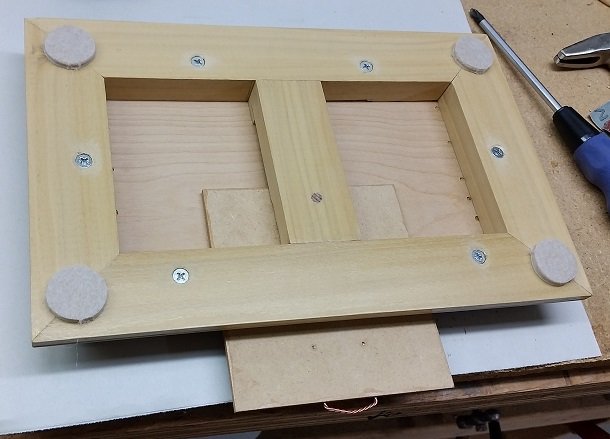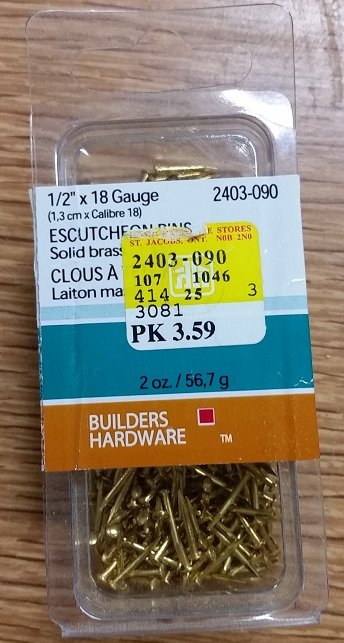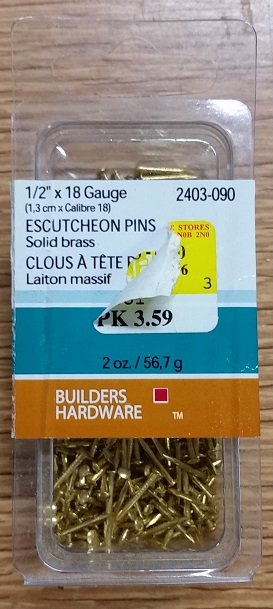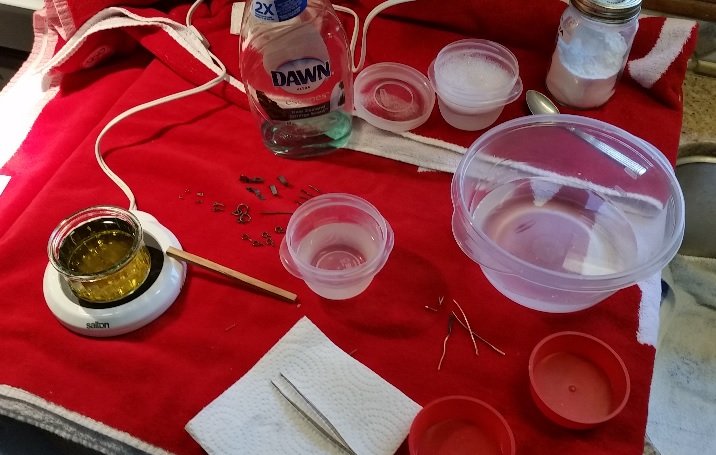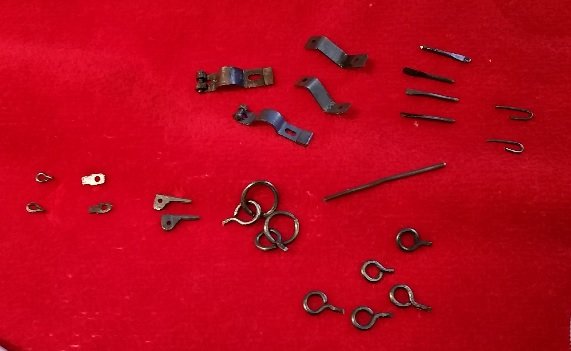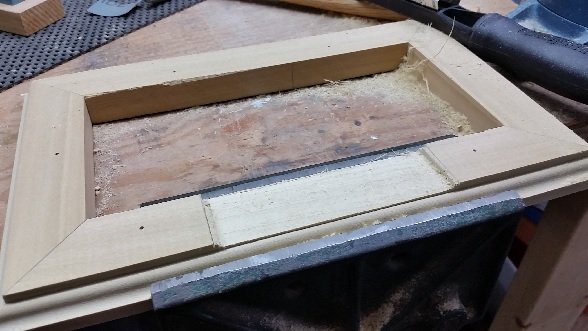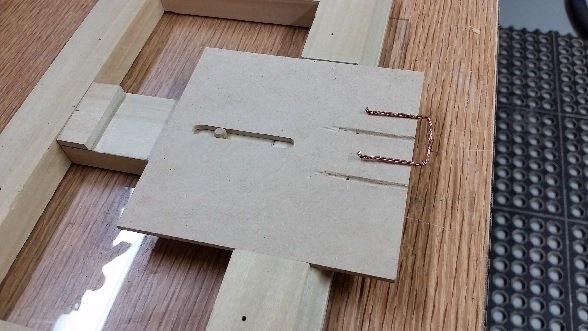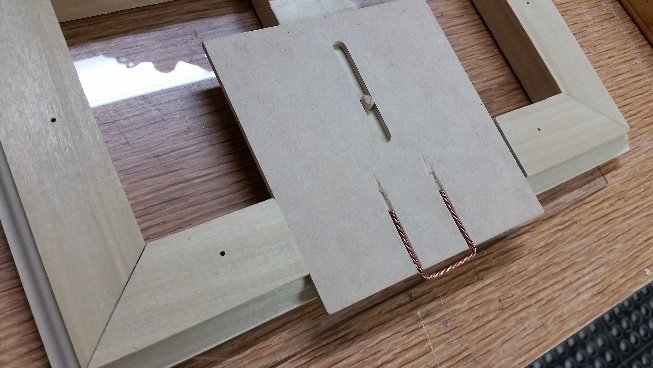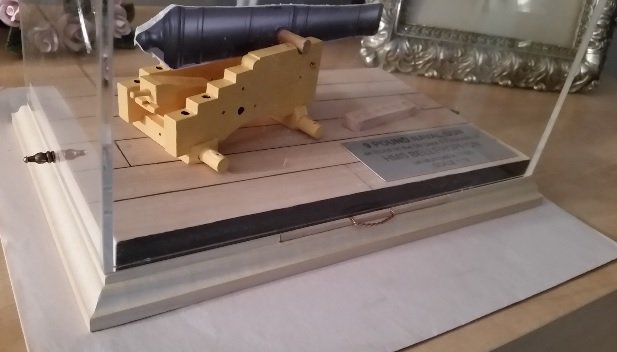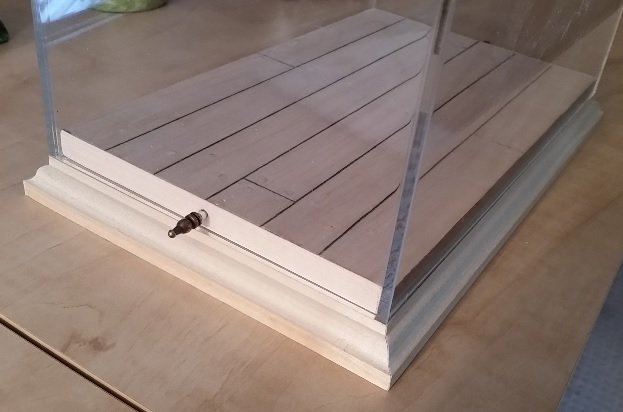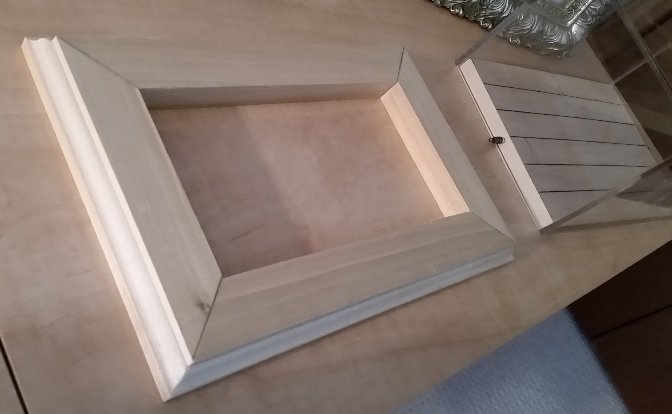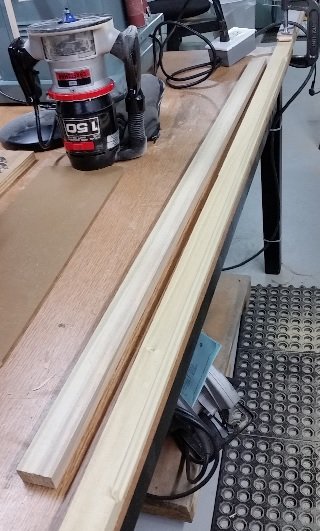-
Posts
2,861 -
Joined
-
Last visited
Content Type
Profiles
Forums
Gallery
Events
Everything posted by AON
-
the Admiral may have something to say about that
-
Thank you Noel. I definitely will look into this product.
- 125 replies
-
- 9 pound naval cannon
- 3d cannon barrel
-
(and 1 more)
Tagged with:
-
I think it is a distributor. Possibly they meant "brass-ish".
- 125 replies
-
- 9 pound naval cannon
- 3d cannon barrel
-
(and 1 more)
Tagged with:
-
Found some stainless steel screws that were 3/8" (9.5mm) too long which worked out well after I cut the extra length off the pointy tip. This meant the amount that engaged (3/8") was all full form threads. Drilled the pieces and countersunk for the screw head. Assembled it all and the drawer would not pull out. I had to sand the thickness of the varnish off the frame under the sliding tray. Now everything works well. The new aluminium plates were installed, along with the felt foot pads... and a couple photos were taken. Next week (Tuesday) I take the 3D printing seminar and then I'll get my cannon printed up. You will hear from me after that. PS: Yesterday was our 43rd wedding anniversary.... today I turned a year older.
- 125 replies
-
- 9 pound naval cannon
- 3d cannon barrel
-
(and 1 more)
Tagged with:
-
here is the packaging and description. I purchased these quite some time ago.. but that doesn't explain it. Staining done. Two coats of varnish done to seal the base frame. Assembly today. 3D printing course next week... and a barrel shortly afterwards.
- 125 replies
-
- 9 pound naval cannon
- 3d cannon barrel
-
(and 1 more)
Tagged with:
-
I tried acetone, scrubbed, washed, swished... nothing. Let it soak... nothing. Me thinks Home Hardware "got some s'plain'n to do".
- 125 replies
-
- 9 pound naval cannon
- 3d cannon barrel
-
(and 1 more)
Tagged with:
-
Thank you Druxey but they are already blackened with a marker and installed. I had tried sanding any coating off the head and it didn't seem to help. I'll try acetone tomorrow just for the heck of it. Presently trying to figure out how to drill and pin two of the four trucks so it is fixed to the mounting board and doesn't roll around when she heels over when handled.
- 125 replies
-
- 9 pound naval cannon
- 3d cannon barrel
-
(and 1 more)
Tagged with:
-
After all the hullaballoo (of my own making) over figuring out how to blacken properly... it turned out to be very easy. I set up a work station, in the kitchen, on the counter, window to one side cracked open, stove overhead exhaust fan to the other side and turned on high. One small container with cleaning solution (drop of soap and ammonia). One small container with hot water and baking soda solution to stop the process. One large container with clean hot water to rinse parts off in after treating. One small container with hot water and a small amount of crushed rock liver of sulfur mixed with a wooden stir stick. Set this on my abandoned coffee mug warmer. Pair of latex gloves and tweezers. Cleaned, rinsed and dried the parts. Picked each part up with tweezers and swished (stired about in the solution while holding the part with the tweezers) them in the LOS solution for 5 seconds. Took it out and it was turning black. Did it again quickly... then once more and then into the baking soda solution... swished it about. Then into the clean rinse and done. Repeated this for every part. The copper blackened very quickly. The brass was a problem. I swished and waited and swished and waited and nothing. I let it sit for quite some time (20 minutes) and nothing. After 33 minutes they seemed to be dulling abit.... but it was wishful thinking. After 50 minutes I told myself to stop. I am thinking they are calling these brass but possibly they are not... the packing reads: "solid brass". As you only see the head of these I have decided to blacken them with a black permanent marker.
- 125 replies
-
- 9 pound naval cannon
- 3d cannon barrel
-
(and 1 more)
Tagged with:
-
Went back to the engraver's and admitted to my mistakes. Asked if he had an idiot's discount. Got a call today to advise they were ready and I could have the two for the price of one. Sweet
- 125 replies
-
- 9 pound naval cannon
- 3d cannon barrel
-
(and 1 more)
Tagged with:
-
The poplar sub-base was just stained with a Minwax Penetrating Stain #260 - Pickled Oak to bring out the grain but keep the clear unfinished look. It is presently drying. A clear sealing coat of Varnish will be applied afterwards. The MDF will be varnished only. The sub-base will then be screwed to the underside of the mounting plate from below and felt pads will be added to protect table tops from any scratches. Meanwhile I've done some more research into using lump or rock form Liver of Sulphur (LOS) that I had purchased and used once before about a year ago blackening the staples on the keel of my ship build. That attempt had flaked off but fortunately I liked the end result. I'm guessing I possibly did three things wrong back then: too strong a mix of LOS to water, too cool a mix when the blackening process took place, and too long a soak in the mix. The following PDF is a summary of the instructions I'll be following. I have also included a MSDS for LOS. I will be doing some practise runs on copper wire and brass nails before I commit to blackening the pieces to be used. This will happen tomorrow. How to Patina Copper and Brass.pdf MSDS_LiverofSulfur.pdf
- 125 replies
-
- 9 pound naval cannon
- 3d cannon barrel
-
(and 1 more)
Tagged with:
-
Well, I don't know you very well Druxy, but you seem very informative. I've noticed you've helped quite a few people on the forum (besides me). On the other hand I know David Antscherl is a master at modelling and very knowledgeable (because he does the research) and I'd trust him in a heart beat... but he'd want me to research on my own first, so I have done just that before I see him this coming weekend. Thank you again... BTW - I just explained to my wife how I wasted some money. YIKES
- 125 replies
-
- 9 pound naval cannon
- 3d cannon barrel
-
(and 1 more)
Tagged with:
-
and now this... https://books.google.ca/books?id=7qwfBestmOEC&pg=PA73&lpg=PA73&dq=bolting+and+plugging+wooden+ship+deck+planks&source=bl&ots=ByXVbG9X2M&sig=EtcUEYK6IUb3MPaKNfqzrWa5vdQ&hl=en&sa=X&ved=2ahUKEwi-1Jr4m8reAhUETd8KHYoCBngQ6AEwFHoECAoQAQ#v=onepage&q=bolting and plugging wooden ship deck planks&f=false Funny how I couldn't find anything before. So it is officially bolted with wooden plugs overtop. Thank you Druxey for mentioning this. This I will never ever forget.
- 125 replies
-
- 9 pound naval cannon
- 3d cannon barrel
-
(and 1 more)
Tagged with:
-
and just found this in the forum with a slight change in my search criteria ( https://modelshipworld.com/index.php?/topic/14473-treenalingwish-i-hadnt-done-this/&tab=comments#comment-449644 )
- 125 replies
-
- 9 pound naval cannon
- 3d cannon barrel
-
(and 1 more)
Tagged with:
-
I've spent some time trying to find information of deck fastening. In the Model Shipwright Magazine, issue 63 (dated March 1988) on page 53 is Part 9 of a good series of articles by David White entitled Traditional Wooden Shipbuilding. I think I will be allowed to post a screen shot snip of one paragraph (see below). It substantiates in part what Druxey had stated earlier. David White does not mention plugs but plugs make sense. I will continue to search.
- 125 replies
-
- 9 pound naval cannon
- 3d cannon barrel
-
(and 1 more)
Tagged with:
-
I could but it will likely look like heck. They have a special sheer for metal nameplates to assure the edges are crisp and flat. I could ask them to cut it for me.... but it was not the look I agonized over for a couple weeks. I'll have to sleep on this, but thank you for the suggestion.
- 125 replies
-
- 9 pound naval cannon
- 3d cannon barrel
-
(and 1 more)
Tagged with:
-
I have such a thing. Spring loaded barrel, fits in your palm...push with your palm. It bought it years ago to insert finish nails into things like picture frames or paneling onto walls. You have to be very careful with the amount of pressure. Never thought to try it on pins for a model. Now I have to find it again.
-
I wish I had caught it before the engraving was done.
- 125 replies
-
- 9 pound naval cannon
- 3d cannon barrel
-
(and 1 more)
Tagged with:
-
Next is staining the sub-base, blackening the copper and brass, getting one or possible both plates engraved again, assembling everything ... except the cannon itself. Should have all (but the cannon) done next week.
- 125 replies
-
- 9 pound naval cannon
- 3d cannon barrel
-
(and 1 more)
Tagged with:
-
Then I started working on the sliding information tray. I made a support bridge piece between the frames, marked the depth, wood rasped and then sanded to the marks. Drilled and inserted the stopper dowel. I didn't get any photos of it until the final assembly. Marked the location, depth and width on the front frame piece then I cut it down. The sliding "tray" is a piece of MDF (medium density fiberboard) wide enough for the nameplate and deep enough to have a slotted hole to encapsulate the locking pin in a slotted hole. The pull out handle is made of three strands of 0.031" copper wire twisted together to look like rope. One end of the group of wires was clamped in the vise and the other end in the chuck of my variable speed drill. I ran the drill to twist the wires until I had the look I wanted. The wire was bent and the fiberboard was grooved for the wire to sit into, below the surface so the nameplate would sit flat (no bump). As an added precaution the ends of the wire were bent 90° downwards to fit into holes drilled at the end of each groove so when pulling on the wire it has additional holding power to the MDF. This was assembled and glued together. Then the tray was assembled to the sub-base and tested.
- 125 replies
-
- 9 pound naval cannon
- 3d cannon barrel
-
(and 1 more)
Tagged with:
-
Had to go get my mitre saw from my son (he used it to build his garage) and cut the 45° mitres. Dry fitted them under the mounting board and case and made adjustments to get the "shelf" closer to the outer edge of the case. Then I sanded it down to the mark. Double checked and finally glued and clamped the pieces together.
- 125 replies
-
- 9 pound naval cannon
- 3d cannon barrel
-
(and 1 more)
Tagged with:
-
Worked on the sub-base frame. Practised routering on a piece of scrap to determine which profile was best out of three I had picked out. Decided on a 5/32" Roman Ogee profile. Took my length of 34" x 1-1/2" Poplar and with a 4 foot piece to ride on in behind it so the router didn't rock I cut the profile.
- 125 replies
-
- 9 pound naval cannon
- 3d cannon barrel
-
(and 1 more)
Tagged with:
-
Okay. No one asked. I had transposed the year of launch... 1786 was written and then engraved as 1768. Really dumb... my dyslexia exposed to the world.
- 125 replies
-
- 9 pound naval cannon
- 3d cannon barrel
-
(and 1 more)
Tagged with:
-
I am afraid if it was my mistake he would not accept any fault (or off any discount to the price) Ship Modeling from Stem to Stern by Milton Roth, pg 125 mention deck treenails. Historic Ship Models by Wolfram zu Mondfeld, pg 98 mentions deck treenails. He states "Please note: on iron framed ships - that is, after 1850 - no treenails or nails should be visable, but the wooden plugs covering the fixed bolts would be and would appear similar to treenails with a cross instead of an end grain." TFFM Vol 3 by Greg Herbert, Pg 157 mentions deck treenails. (funnily the other volumes of TFFM by David Antscherl does not mention treenails at all that I can find". I expect to see him on the 18th at our club meeting and will ask). I confess to not know any more than I read. Do you have a source of this info Druxey? BTW - I did find an error... of my doing.
- 125 replies
-
- 9 pound naval cannon
- 3d cannon barrel
-
(and 1 more)
Tagged with:
About us
Modelshipworld - Advancing Ship Modeling through Research
SSL Secured
Your security is important for us so this Website is SSL-Secured
NRG Mailing Address
Nautical Research Guild
237 South Lincoln Street
Westmont IL, 60559-1917
Model Ship World ® and the MSW logo are Registered Trademarks, and belong to the Nautical Research Guild (United States Patent and Trademark Office: No. 6,929,264 & No. 6,929,274, registered Dec. 20, 2022)
Helpful Links
About the NRG
If you enjoy building ship models that are historically accurate as well as beautiful, then The Nautical Research Guild (NRG) is just right for you.
The Guild is a non-profit educational organization whose mission is to “Advance Ship Modeling Through Research”. We provide support to our members in their efforts to raise the quality of their model ships.
The Nautical Research Guild has published our world-renowned quarterly magazine, The Nautical Research Journal, since 1955. The pages of the Journal are full of articles by accomplished ship modelers who show you how they create those exquisite details on their models, and by maritime historians who show you the correct details to build. The Journal is available in both print and digital editions. Go to the NRG web site (www.thenrg.org) to download a complimentary digital copy of the Journal. The NRG also publishes plan sets, books and compilations of back issues of the Journal and the former Ships in Scale and Model Ship Builder magazines.




